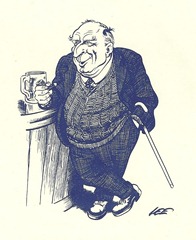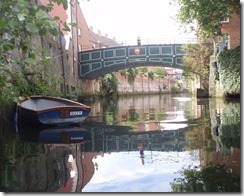MENTION “Jonathan Mardle” to any card-carrying EDP reader over a certain age and they are bound to nod knowingly. “Jonathan Mardle” (pictured left) was the pseudonym of leader writer Eric Fowler. His weekly essays appeared in the paper from 1946 right through to his death in 1981. To my mind he was a great writer. Certainly his love for the county of Norfolk shines through every sentence. I picked up “The Best of Jonathan Mardle” from a second hand book shop in Cromer last summer and his stuff just hasn’t dated. Or at least if it has dated, it still makes sense. June 1956 sees him wishing that “Norwich from the River” would look more attractive. Compared to his description, I think you’ll agree we’ve made great strides in half a century. It is, he says:
“sadly apparent that the river, as it passes through the heart of the city becomes a very dirty stream, and moreover that great lengths of its banks are still used like a slum or a lumber yard. ..The impression of neglect is deepened if you go through Norwich by boat from Carrow to the New Mills. Few of the present generation of citizens have ever done this: and indeed I myself did it for the first time only about a month ago, through the kindness of a friend who had his motor boat at Whitlingham. The little port of Norwich with its slab-sided coasters discharging coal and grain and loaded scrap iron is fun, as any place frequented by ships must be. But once you are past Carrow Works, the flour mill and the brewery, the bank on your left as you go upstream is a horrid mixture of empty slums and dumps of waste paper and scrap iron. It is a poor sort of salute to the visiting yachtsmen whom we invited to explore the beauty of Norwich.”
“…Up to Bishop Bridge it is pleasant enough if you can ignore the oily scum on the water, Beyond that fine old bridge too, the city looks gracious, with a tree clad bank on the right …and to the left the old brick tower standing in the meadow of the Great Hospital. Then factories to the right, the Hospital gardens to left; but next – angels and ministers of grace defend us! – the gasworks. The old yarn factory (now Jarrold’s printing works) on the opposite bank, is mellow and graceful in comparison – some Georgian sense of style and proportion still pervaded the local factory architecture in 1839, Whitefriars Bridge, of the present century is distinctly inferior…”
“Above the Duke Street bridge the water was so low that we ran aground; then chugged along at half speed, with rubbish chocking the propeller, until we reached the narrows between the high brick walls of Bullard’s Brewery – more of those old industrial buildings which have a certain antique charm about them.
“So I cannot commend the voyage, except, as unusual. But I can visualise what it might be if in the rebuilding of the derelict area between King Street and the river we built some pleasant houses with lawns and gardens; if the gas works with their ugliness, dirt and effluent, were removed …and other houses with gardens put in their place; if more industrialists would think of the riverside as a frontage, and not as a backyard with a drain running through it; if all of us thought of the river as something that ought to be a joy to see.”
Well I did “Carrow to the New Mills” by kayak last summer and while we haven’t got everything right, I think I’d give today’s Wensum a good nine out of ten. Hats off to the vision of that visionary Mr Mardle.


Fascinating memories and insight into Norfolk history, as always. Thank you.
ReplyDeletePhoto of the old boy here:
ReplyDeletehttp://www.flickr.com/photos/cameron_self/4256593422/
Nice one Cam.
ReplyDelete